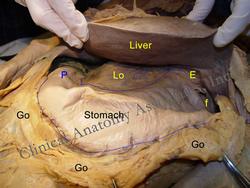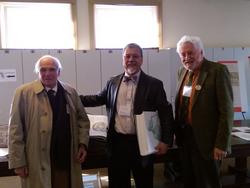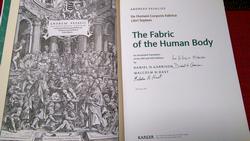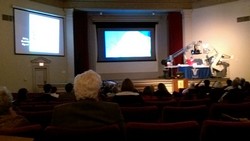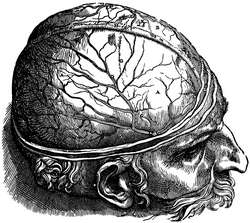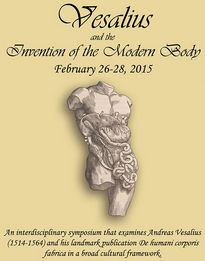
Medical Terminology Daily (MTD) is a blog sponsored by Clinical Anatomy Associates, Inc. as a service to the medical community. We post anatomical, medical or surgical terms, their meaning and usage, as well as biographical notes on anatomists, surgeons, and researchers through the ages. Be warned that some of the images used depict human anatomical specimens.
You are welcome to submit questions and suggestions using our "Contact Us" form. The information on this blog follows the terms on our "Privacy and Security Statement" and cannot be construed as medical guidance or instructions for treatment.
We have 1261 guests online

Georg Eduard Von Rindfleisch
(1836 – 1908)
German pathologist and histologist of Bavarian nobility ancestry. Rindfleisch studied medicine in Würzburg, Berlin, and Heidelberg, earning his MD in 1859 with the thesis “De Vasorum Genesi” (on the generation of vessels) under the tutelage of Rudolf Virchow (1821 - 1902). He then continued as a assistant to Virchow in a newly founded institute in Berlin. He then moved to Breslau in 1861 as an assistant to Rudolf Heidenhain (1834–1897), becoming a professor of pathological anatomy. In 1865 he became full professor in Bonn and in 1874 in Würzburg, where a new pathological institute was built according to his design (completed in 1878), where he worked until his retirement in 1906.
He was the first to describe the inflammatory background of multiple sclerosis in 1863, when he noted that demyelinated lesions have in their center small vessels that are surrounded by a leukocyte inflammatory infiltrate.
After extensive investigations, he suspected an infectious origin of tuberculosis - even before Robert Koch's detection of the tuberculosis bacillus in 1892. Rindfleisch 's special achievement is the description of the morphologically conspicuous macrophages in typhoid inflammation. His distinction between myocardial infarction and myocarditis in 1890 is also of lasting importance.
Associated eponyms
"Rindfleisch's folds": Usually a single semilunar fold of the serous surface of the pericardium around the origin of the aorta. Also known as the plica semilunaris aortæ.
"Rindfleisch's cells": Historical (and obsolete) name for eosinophilic leukocytes.
Personal note: G. Rindfleisch’s book “Traité D' Histologie Pathologique” 2nd edition (1873) is now part of my library. This book was translated from German to French by Dr. Frédéric Gross (1844-1927) , Associate Professor of the Medicine Faculty in Nancy, France. The book is dedicated to Dr. Theodore Billroth (1829-1894), an important surgeon whose pioneering work on subtotal gastrectomies paved the way for today’s robotic bariatric surgery. Dr. Miranda.
Sources:
1. "Stedmans Medical Eponyms" Forbis, P.; Bartolucci, SL; 1998 Williams and Wilkins
2. "Rindfleisch, Georg Eduard von (bayerischer Adel?)" Deutsche Biographie
3. "The pathology of multiple sclerosis and its evolution" Lassmann H. (1999) Philos Trans R Soc Lond B Biol Sci. 354 (1390): 1635–40.
4. “Traité D' Histologie Pathologique” G.E.
Rindfleisch 2nd Ed (1873) Ballieres et Fils. Paris, Translated by F Gross
"Clinical Anatomy Associates, Inc., and the contributors of "Medical Terminology Daily" wish to thank all individuals who donate their bodies and tissues for the advancement of education and research”.
Click here for more information
- Details
The term [urination] comes from the Greek [ούρα] meaning "urine" and refers to the "expulsion of urine". The term [micturition] has a Latin origin and refers to the "desire to empty the urinary bladder". Through use, these two terms have become synonymous.
Although the common use of [urination] is the act of bladder emptying, the proper use of the term describes the constant passage of urine from the ureters into the urinary bladder. The proper term for bladder emptying is [micturition].
The fact is that we are constantly urinating (right now as your are seated in front of your computer), but only micturate a few times a day.
Original images by Henry VanDyke Carter, MD and links courtesy ofbartleby.com
- Details
UPDATED: The word [pylorus] is Greek. It arises from the word [πύλη] (p?li)meaning [gate]. In ancient Greek [πυλωρός] (pylorus) meant "gatekeeper" or "gate guard", leaving us to assume that Greek physicians had an idea of the function of the pylorus.
The pylorus is a true anatomical sphincter and controls the emptying of the stomach. It is the most distal anatomical component of the stomach and can be see in the image marked with the letter "P". In history, it has been described by other names including "velut portanarium", and "pilorium" this last term was changed to "pylorus" by Andrea Vesalius.
Using surface anatomy the location of the pylorus can be found on or slightly superior to the transpyloric plane and slightly to the right of the midline.
Stenosis of the pylorus can lead to gastric emptying complications. A couple of surgical procedures to alleviate this condition are:
• Pyloromyotomy: From the root terms [pylor], meaning "pylorus", [-my-], meaning "muscle", and the suffix [-otomy], meaning "to open, or to cut"; therefore "opening of cutting the pyloric muscle"
• Pyloroplasty: From the root terms [pylor], meaning "pylorus", and the suffix[-oplasty], meaning "to reshape or reconstruct"; therefore "pyloric reshaping".
The image shows the anterior aspect of the stomach. The liver is retracted. Go= Greater omentum, Lo=Lesser omentum, E= Esophagus, f=Fundus, P= Pylorus.
Images property of:CAA.Inc.Photographer:D.M. Klein
- Details
A fistula is the abnormal communication or passageway between two hollow organs or between a hollow organ and the skin.
The term fistula is also used as a synonym for an anastomosis.
- Details
Andreas Vesalius opus magnus was the creation and the publication of his book “De Humani Corporis Fabrica, Libri Septem" (Seven books on the structure of the human body). This book was published on May 26th, 1543 by the printing press of Johannes Oporinus.
Much has been said and written about this book and the influence of Vesalius’ work on scientific thinking, the scientific method, and the displacement of dogmatic thinking based on the works of the ancient Greeks and Galen of Pergamon (129AD - 200AD) for a different view of the construction of the body based on direct and empirical observation.
Unfortunately, because of Vesalius’ following of Erasmus’ teachings on Latin, the book was written in a very difficult and circumvoluted language which made it difficult to understand. In addition, the book was very expensive for the times, with an estimated maximum printing of 600 copies.
Were it not for the images and the captions, as well as the many plagiarized versions of the Fabrica in different languages, Vesalius opus magnus would have been lost to history. Harvey Cushing wrote in his Vesalius bio-bibliography of 1943:”As a book, the Fabrica has been probably more admired and less read than any publication of equal significance in the history of science”.
Although several attempts have been done to translate the Fabrica, most of the works have been incomplete, or have tried to paraphrase or correct Vesalius’ words, leaving us with a watered-down image of the author and his intent.
In 1993 Drs. Daniel H Garrison and Malcom H. Hast began a collaboration to translate the Fabrica of Vesalius. The 20- year story of how they obtained federal grants, discussed the translation, found a publisher, scanned and improved on the original images of the Fabrica, and how they even worked with Christian Mengelt to create a new typography for an annotated new Fabrica, was part of their presentation on the interdisciplinary symposium “Vesalius and the Invention of the Modern Body” hosted by the St. Louis University and the Washington University February 26-28, 2015.
This annotated new Fabrica is a translation of the 1543 first edition with comments on the 1555 second edition and it also includes passages and comments from a heavily edited 1555 second edition that has side margins comments and corrections now certified to be in Vesalius’ own handwriting. This book has been speculated to have been Vesalius’ personal copy and probably the basis of a potential third edition. This particular book is now known as "Vesalius' Annotated Fabrica"
The "New Fabrica" was published in 2013 by Karger Publishing, a company based in Basel, Switzerland, the same city where the original Fabrica was published in 1543. The ISBN is 978-3-318-02246-9. Only 948 books were published and it has now been sold out. Because of the demand, an original is now considered a rare book.
Daniel H. Garrison received his degrees from Harvard (A.B. Classics, 1959) and Berkeley (PhD Comparative Literature, 1968). He was a member of the Classics Department at Northwestern University from 1966 until his retirement in 2010.
Malcolm H. Hast is Professor Emeritus of Otolaryngology – Head and Neck Surgery – and also past Professor of Cell and Molecular Biology (Anatomy) at Feinberg School of Medicine of Northwestern University. He is Fellow of the American Association for the Advancement of Science as well as Fellow of the Anatomical Society (UK) and a Chartered Biologist and Fellow of the Society of Biology (UK). He is also a recipient of The Gould International Award in Laryngology and a NATO Senior Fellowship in Science.
Personal note: I am honored to have met both Drs. Garrison and Hast at the symposium, shared some of the stories behind the new Fabrica and have them sign my own copy of this incredible book. Dr. Miranda
Sources:
1. "A Bio-blibliography of Andreas Vesalius" Cushung, H. 1943 Saunders
- Details
The terms “anatomy” and “dissection” are synonymous. In the days of Andreas Vesalius, the dissection of a corpse was a public event, where medical students would attend, as well as the paying public.
This event would go on for days as the dissector would explain the anatomy racing against time, as there were no means of body preservation.
Through the centuries after the public anatomies of the 1500’s, the dissection of donated bodies has been continued in the anatomy departments of medical schools helping medical students and surgeons prepare for the challenges of the practice of medicine and surgery.
A public anatomy was one of the events of the interdisciplinary symposium "Vesalius and the Invention of the Modern Body" hosted by the St. Louis University and the Washington University February 26-28, 2015. To my knowledge, a public anatomy has not been done in centuries (I may be wrong).
Some of the objectives were to demonstrate that Andrea Vesalius' description of the anatomy of the brain, its ventricular system, and the cranial nerves was logical, followed a process, and that the Fabrica, in its seventh book can be used as a dissector. The presentation was entitled “A Fabrica-guided Neo-Vesalian Public Dissection of the Brain Ventricular System 500 Years Later at St. Louis University” by Dr. Salomon Segal.
The dissection used excerpts and images from the Fabrica, as well as an advanced HD 3D camera, showing the brain and its structures with amazing clarity. The accompanying photo of the event is not well focused because of the light conditions, but shows the setup for the presentation.
This was an extremely professional presentation and although not completely “public” per se, the variety of attendees had a great feedback on the event. Proper attention to the care and respect towards the specimens and the anonymity of the donors was maintained at all times. I consider myself honored to have been a witness and a participant to this extraordinary event. Dr. Miranda.
- Details
- Written by: Efrain A. Miranda, Ph.D.
Last week I attended this interdisciplinary symposium hosted by the Saint Louis University and Washington University. This three-day event was inspired by the landmark publication of Andrea Vesalius’s "De humani corporis fabrica, libri septem" (Basel, 1543 and 1555) and the new critical edition and translation of this work, the New Fabrica. Two of the keynote speakers were Daniel Garrison and Malcolm Hast, authors of the new Fabrica by Karger Publishers. Besides them there were several internationally-renowned speakers, art exhibits, presentation of academic papers of leading research, a public anatomy demonstration, rare books workshops, and a publishers’ exhibit hall.
Because the Fabrica represented a collaborative project involving a scientist (Vesalius), a humanist (Johannes Oporinus, the printer), and an artist (Jan van Kalkar), the goal of the conference was to encourage a network of scholars working in disparate fields to explore the potential for future interdisciplinary research. This objective was clearly attained, as I was able to speak and share with rare books curators, university librarians, artists, anatomist, physicians, poets, historians, etc., all of them brought together by the shared admiration for Andreas Vesalius, his work, his publications, and his legacy.
There were many highlights in this symposium and I will try to cover some of them in a series of articles. The first one was a presentation by Dr. Stephen N. Joffe, where he described the number of Vesalius' books still in existence in the US and estimates around the world. It was interesting to me that and estimated 600 first edition Fabricas were ever published, and that of those only a fraction exist today, most in university libraries!
Another highlight was the presentation by Pascale Pollier, a Belgian artist, of the Vesalius Continuum project, part of which are the Fabrica Vitae art exhibit that was available to the attendees and the public for the duration of the symposium. Another part of Vesalius Continuum was the meeting in Zakynthos, Greece in 2014. Pascale also presented the process of creation of a bust of Dr. Gunther Von Hagens, the inventor of the system of plastination.
Probably the most rewarding segments of this symposium were the question and answer sessions after each presentation.



